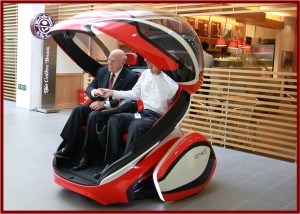
GM China’s EN-V first shown in 2010 looks to have evolved into a serious development program with global sales potential.
General Motors China has celebrated the opening of the second phase of its automotive development center in China. Eventually as many as 250 engineers, designers and researchers will work in advanced vehicle design, powertrain and vehicle engineering, telematics and R&D at the center located on a sprawling site in Shanghai. Their job is to improve GM products with a concentration on fuel economy, as well as increase the pace of GM’s introduction of “innovative technologies.”
“It gives us the most comprehensive automotive technical center in our largest market. The center will serve not just China, but also GM’s operations around the world,” said Bob Socia, president, GM China.

GM China claims to have already has made significant breakthroughs in the development of lightweight materials such as magnesium alloy to improve the fuel economy of its vehicles.
Engineers and technicians at the ATC will test vehicle subsystems and components under varying conditions in the labs dedicated to Concept Vehicle Integration, Structures and Chassis, Vehicle Assessment and Benchmarking, Electrical, HVAC (Heating, Ventilation and Air Conditioning), Materials and Fastening, and Powertrain.
China, is the world’s largest auto market and GM and its joint ventures with local partners – required for market access – combined are the largest automotive group in a country with more than 3 billion people. Shanghai GM builds, sells and – to limited degree imports – Buick, Cadillac and Chevrolet vehicles. In 2011, it had record domestic sales of 1.2 million vehicles, virtually all of them locally produced.
Increasingly, sophisticated engineering and development work once done in the U.S. is being shifted to China. Last August, GM began fabricating and testing prototype battery cells and complete systems at the ATC. At the same time, SAIC and Shanghai GM and the Automotive Technical Center opened China’s largest proving grounds with 37 miles or 60 kilometers of test roads. The 5.67-square-kilometer (2.18 square miles) Guangde Proving Ground in Guangde County can simulate and test 67 different driving conditions.
GM China claims to have already has made significant breakthroughs in the development of lightweight materials such as magnesium alloy to improve the fuel economy of its vehicles. The Micro-foundry and Formability Lab, part of the first phase of the ATC that opened in September 2011, has completed magnesium alloy low-pressure die casting testing. This is said to be a “milestone in lightweight materials research” for the automotive industry.
It is in part the transfer of white-collar professional salaried jobs from the U.S. taxpayer controlled company to the businesses operating in the world’s largest auto market. GM and its shareholders have little choice here. State run capitalism in China is strictly regulated by the Communist Party in what is a successful jobs creation program that requires local partners and onshore investment as the price of doing business. If you are going to survive in the global automobile business, a company needs to be successful in China.
“Our new Advanced Design Center in Shanghai is part of the GM Global Design Center network, which webs from California to Germany to India and Korea and points beyond,” said Wulin Gaowa, design director of the GM China Advanced Design Center. “We are building a team of talented local designers and modelers that will enable us to deliver world-class work for China and other markets.”
For example, milling machines produce clay models in scale using computerized three-dimensional data. Designers use these models to evaluate vehicle proportions, finalize surfaces and graphics during the design process.
At the celebration yesterday in Shanghai, GM showed a life-size clay model of the EN-V 2.0, which is based on the EN-V concept introduced at Expo 2010 in Shanghai. The original EN-V, an acronym for Electric Networked-Vehicle, was a two-seat electric vehicle designed to alleviate traffic congestion, parking and air quality issues for tomorrow’s cities. The concept embodies the company’s vision for sustainable urban mobility, combining electrification and connectivity. A sketch of the EN-V 2.0 concept was shown earlier this year at the Beijing auto show in what looks to have evolved into a serious development program with global sales potential.
See:

